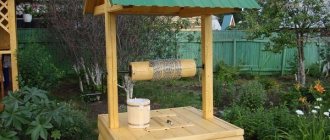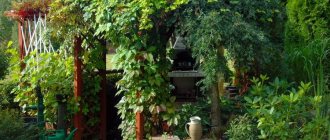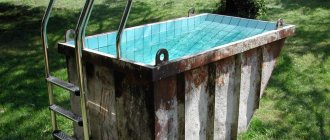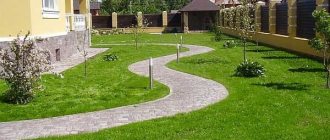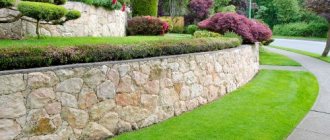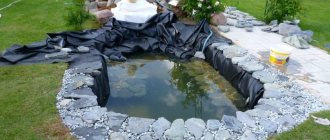Rock gardens, like rock gardens, belong to one of the popular types of gardens - rocky gardens. Initially, “rock garden” was the name given to a rocky garden (Rock – rock), “rock garden” meant a garden exclusively with alpine, and later with other alpine plants. Rockery is a rocky garden. 40 photos of rock garden design.
In modern gardening, both words have acquired a slightly different meaning: a rock garden refers to alpine slides, artificially constructed, decorated with stones, ground cover and low-growing (dwarf) plants, among which alpine ones may also be present.
We call a rock garden a rocky garden on a flat (possibly sloping) surface. Unlike a rock garden, a rock garden in a country house can be large in size, and the plants can be quite large. A large rock garden can lose all its charm. In both cases, plants for rockeries are selected that do not grow too much, and are usually compact. Rockery photo design:
What is a rockery?
A rock garden is a real work of art - a garden of stones and plants that, at first glance, are absolutely incompatible with each other.
Making a rock garden is not only simple, but also very practical. A stone garden does not require watering, weeding or constant maintenance, which is greatly appreciated by owners of dachas and country houses who want to enjoy natural beauty and do not like to waste time on excavation work.
Setting the stage
For most vegetation, a mixture of turf soil, leaf soil, sand and peat is suitable. If the rock garden is located on a hill, artificial or natural, you need to give it time to settle for a couple of months. After some time has passed, add fresh soil and you can plant.
Plants are planted in a certain order, first woody conifers, then deciduous shrubs, and then creeping ground covers.
Advice! You should not add nutritional supplements to the soil, as this will lead to rapid plant growth.
Main types of rockeries
- English rockery
The English conservatory is distinguished by an abundance of greenery, mainly various cereals, wormwood and conifers. The result is a classic, seasoned look of rockery.
- Japanese rock garden
Japanese rock garden, on the contrary, is famous for its abundance of stones and minimalism in plants. The Japanese consider these works of art to be their property, so each of them has such a garden, at least the smallest one. Caring for it is not difficult, because the stone will never change its shape and can be polished periodically with a file :)
- European rock garden
The European rockery is immediately visible - hemp, juniper, potatoes with onions and leeks. Okay, I’m kidding, otherwise you’ll create not a rockery, but a rockery :) A European rockery is one where preference when planting is given to plants from the middle zone. Most of these are small shrubs and plants that simply cover the ground.
To make a rock garden with your own hands at the dacha, it is not at all necessary to adhere to a certain style. Make your fantasies come true, combine styles and you will get your own exclusive site design.
IT IS IMPORTANT TO KNOW!
- The rock garden should not be an eyesore and should be in harmony with the architecture of the main buildings
- The shape and size of the plot will tell you which design method to choose for the rock garden
If you are not confident in your abilities, then make a mini rockery. When the principle of the relationship between materials and colors is clear, then you can increase the scale. And the created miniature may well become one of the elements of a full-fledged stone garden.
Place to create a rock garden
If desired, anyone can decorate their plot with a rock garden. Think about where your miracle - the garden - will be located. It is not necessary to level the desired area, even if it is tilted.
Differences in height are welcome - some craftsmen sometimes even resort to artificial embankments, making small hills from sand, soil or stones.
The basic rule when choosing a place for a rock garden is the absence of trees and shrubs on the site, since they are not used when creating rock gardens.
The main criteria for choosing a place for a rock garden:
- if the site area is large, then place the rockery closer to the resting place
- You should not make a rockery next to buildings, as there is a high probability that snow from the roof can damage the flower garden
- if the site already has decorations in the form of bridges, fountains or artificial ponds, it’s worth thinking about how to correctly integrate the rock garden into the overall composition
Rock gardens
This element of garden decor gets its name from the alpine landscape, which is used in the design of a rock garden. How to build a rock garden? To do this, you need to form an earthen embankment on the site, it will serve as a foundation.
We need to place drainage in it, the quality of which will determine the beauty of our oasis. Stones of various sizes and shapes are placed on this earthen mound.
Various flowers will grow through the cracks of these stones. The rock garden is very easy to maintain; it is enough to provide good lighting and place high-quality soil.
Do-it-yourself rock garden - step-by-step guide
A rocky garden can be created either in the shade or in direct sunlight. I can advise beginners to start on the sunny side, as this will greatly simplify the choice of plants. You shouldn’t immediately start with a full-scale project - first try creating a small rock garden no larger than 10 m². Such a garden is easier to care for and will not become a burden for you.
Now we will look at how to make a rockery with your own hands, step by step.
- Step 1
First of all, we prepare the site. We start by removing the soil to a depth of 15 - 25 cm. Carefully remove all roots and spread geotextiles to prevent the growth of weeds. We fill the vacant space with crushed stone, expanded clay, or broken brick.
This is done to form good drainage. If you are creating a flat or gravel rockery, you can do without drainage. In other cases, drainage is indispensable.
IT IS IMPORTANT TO KNOW!
The drainage layer is the most important component of a rock garden. This is done to prevent water accumulation and soil subsidence. If you do not want your work to float away, then pay special attention to this moment.
IT IS IMPORTANT TO KNOW!
If you plan to use particularly large stones in the rock garden, then it is worth making a foundation under the rock garden to prevent further shrinkage.
Then we form the appearance of the future rock garden and spread the turf on it.
- Step 2
We fix the sod and pour a 10 cm thick layer of soil on it.
- Step 3
We begin laying out the stones. Large stones are laid first.
- Step 4
Having laid out the stones, they need to be secured. To do this, the space between them is filled with earth or small crushed stone.
- Step 5
After the stones have been laid out, you need to add compost to the soil. Since rockeries love good draining soil, we mix compost in equal proportions with sand.
- Step 6
Pour the compost onto the soil and distribute it evenly over the rockery with a rake.
After all the operations performed, it is necessary to leave the rockery for 2 weeks to wait for the natural shrinkage of the soil. After this time, you can begin planting plants.
- Step 7
Let's start forming the composition. To do this, we place potted plants on rock gardens in the places where they will be planted.
- Step 8
Let's start planting plants. We clean the roots of the plants from the soil from the pots.
- Step 9
We add fertilizers, but the main thing is not to “overdo it”.
- Step 10
Well, all that remains is to water our creation and enjoy!
IT IS IMPORTANT TO KNOW!
If the area for the rock garden is without hills, then you need to put smoother stones there, and if the relief is pronounced, then sharp-angled stones will look better. There is no need to lay out the rockery only with sharp stones, it will look quite ominous. The largest and most unattractive ones should go down, and the smaller and brighter ones will go up. It is advisable to place one large beautiful stone in the center of the composition; it will create a contrast between gray and green.
What plants to choose for rock gardens
For rockeries, preference is given to those plants that do not require constant care. I recommend that you start planting with conifers, and then move on to perennials and groundcovers.
All plants for rockeries can be divided into 4 conditional groups:
- Dwarf conifers - thuja, juniper, dwarf pines and spruces.
- Groundbloods include phlox, cat's paw and moss.
- Perennials - geraniums, daffodils, tulips, hyacinths and others
- Low-growing shrubs - honeysuckle, cotoneaster, cinquefoil.
Depending on where the rockery is located - in the sun or in the shade, the plants may also vary.
The first table shows plants for rockeries located in a sunny place
| Plants for sunny places | ||
| Name | Height, cm | Flowering time |
| Rejuvenated | 5-50 | June August |
| sedum | 3-30 | June-October |
| Thyme | 5-20 | May-August |
| Lumbago | 10-15 | April May |
| Bloodroot | 10-50 | June-September |
| Phlox | 10-30 | May June |
| Adonis | 10-20 | June |
| Levisia | 10-25 | June July |
| Edelweiss | 10-40 | June August |
| Lavender | 10-30 | May June |
| Iris | 5-20 | May |
| Avens | 5-20 | May June |
| Gentian | 10-40 | May-September |
| Krupka | 5-10 | April May |
| Carnation | 10-20 | May-July |
| Bell | 5-30 | June August |
| Windbag | 10-15 | April May |
| Thrift | 5-10 | May June |
| Rezuha | 5-30 | June July |
| Burachok | 8-20 | May |
| Various bows | 10-50 | May-July |
The second table shows shade-loving plants
| Plants for rock gardens in a semi-shaded place | ||
| Name | Height, cm | Flowering time |
| Colchicum | 10-25 | September October |
| Thrift | 5-10 | May June |
| Breaker | 5-10 | May |
| Adonis | 15-30 | May |
| Yaskolka | 5-20 | May-August |
| Soapwort | 3-30 | May June |
| Mouse jacinth | 10-20 | April May |
| Smolevka | 10-15 | July August |
| Saxifrage | 10-30 | April May |
| Periwinkle | 10-15 | May June |
Beautiful examples
Designers can offer numerous ideas for creating an unusual rock garden. You can use certain components to visually divide the mound into several compact zones, each of which will have its own season.
A similar effect can be achieved using a selection of colors.
For spring you should choose delicate shades of flowers, for hot summer - rich ones, for autumn leaf fall you can choose golden and purple vegetation. The rock garden is an amazing area that will give unforgettable emotions to your family and loved ones.
You can always make adjustments to the flower garden design and change the style of the garden depending on your mood.
Many gardeners make solid rocky mounds from rock gardens. For such a design, you should take a more serious approach to the choice of plant representatives: not every variety is able to withstand such living conditions. Ground plants and saxifrages feel good in such a flower garden.
Original individuals will like the option where the rock garden acts as a wall. This flower garden is a vertical structure that will require a lot of effort to create. This design step will be appreciated by all your friends.
Arranging an unusual stone garden with climbing plants will be the final touch of the composition.
Some owners of summer cottages decide to mix styles when creating a stone garden. The combination of European style with Italian design looks good. With this composition you will get a unique celebration of colors and fragrant flowers.
Three-dimensional artistic ideas are popular. The 3D effect is achieved using a 360-degree view of flower beds with various highlights. This rock garden would be appropriate in a recreation area. The stone garden should be located in such a way that it can be viewed from all sides.
A compact garden from Japan can amaze everyone. In this style, stone blocks will command over small plants. Choose climbing varieties of herbs that have a pleasant aroma. This design evokes a feeling of peace and harmony.
Rockery design styles
So, friends.
The presence of three main types of rockeries does not mean that you should strictly adhere to any one of the directions. Give free rein to your imagination - combine different elements. For example, you can come up with the following rock garden solutions:
- the simplest one is a flat version of rock garden
- you can make a hill or a cliff
- a more complicated option - a terraced flower garden or a retaining wall
- stone slope on the sunny side
- Artificial rocks
As you understand, skillfully selected stones are used to create such a composition. The main emphasis is not on vegetation, but on rocks. For such rockeries, samples of volcanic rocks are usually used: granite, dolomite or tuff. Their natural beauty will create a composition that, with proper care, will delight you for many years.
- Retaining wall
This style of rock garden is suitable for those whose plot has a natural slope. Then the rock garden will perform not only an aesthetic function, but will also find practical application. It can be used as a fence to prevent soil from sliding.
The retaining wall is made mainly with flat stones laid on mortar. If the load on the wall is small, then clay can be used.
- Terraced flower garden
This rockery style is suitable for large areas. It is made in the same way as a retaining wall, using the natural slopes of the site. The multi-level composition allows you to plant not only creeping plants, but also dwarf trees, which gives the rockery a special splendor.
To create terraces (platforms), flat or rectangular stones are used.
- Flat rockery
The most common rockery, in my opinion. Ideal for areas with flat, flat terrain. Thanks to the careful selection of stones and plants, a flat rock garden will become the highlight of your vacation spot. Often a flower garden is divided into several parts by paths.
- Gravel rock garden
The most budget option, since it does not require large boulders. But budget doesn't mean ugly. If you put in a little effort and a little taste, you can get quite a decent result.
So, we looked at the main design styles of rockeries. As you can see, the choice of style is influenced by many factors - the size of the plot, the terrain, the budget.
IT IS IMPORTANT TO KNOW!
When creating a rock garden with your own hands, you need to remember that a rock garden is, first of all, a stone garden, and the plants only complement it.
What ephemeral flowers can be planted on an alpine hill
Ephemeroids are plants that have a very short growing season. They bloom in spring or early summer, after which they shed their leaves. They are planted in rockeries last and only in the fall.
What ephemeral flowers can be planted on an alpine hill?
Snowdrops, white flower beds, corydalis, crocuses, iridodictiums, kandyks, chionodoxes, scyllas, pushkinias, muscari, and, of course, tulips, daffodils and hyacinths are perfect for these purposes. They bloom for a short time, but are catchy and impressive, for which they are loved by gardeners.
These plants for rockeries have a single, but serious drawback - after flowering they look inconspicuous, and during the period of foliage dying off they do not decorate the rock garden, but rather spoil it. However, there is no need to abandon ephemeroids - you just need to choose the right types.
Rockery care
The main advantage of a rock garden over an alpine slide is that it requires minimal care. But this does not mean that care is not needed at all.
Well, first of all, a stone garden is not a flower bed. When creating a rock garden, plants are selected that are climate-resistant, perennial and unpretentious.
Basic criteria for caring for rock gardens:
- Periodically water the rockery from a watering can
- Remove dead stems or dried flowers
- Add soil periodically (once every two years or whenever)
- Fertilize your plants, but don't overdo it.
- If the plants have grown too much, they need to be thinned out.
- It is advisable to cover the rockery for the winter
By following these simple instructions, you will significantly extend the life of your “brainchild”.
How to select and install stones
The photo shows that each pebble literally lies in a special place reserved specifically for it. Let's figure out how to lay out stones correctly if you don't have a video with recommendations and couldn't find good diagrams.
- First of all, we pay attention to large stones. Because they will become the basis of your garden. Choose pebbles that have a natural appeal.
- We take 2-3 large stones as a base. They are quite enough to create a mini rockery or a medium-sized composition.
- Do the stones have different shades? This is more of a plus than a minus. The only point is that there is less gray granite. He will simply get lost among the abundance of greenery.
- Before installing large stones, the soil underneath them is concreted. We have already talked about this, but we will repeat it again. Otherwise, the boulders will simply fall through the ground.
We also recommend reading
- How to make an alpine slide correctly
- How can a dry stream transform your dacha?
Choosing a stone for backfilling (video tips)
Basic mistakes when creating rockeries
To prevent your rocky garden from looking damaged, let’s look at the main mistakes that beginners make:
- The key to success is the right choice of location
- You shouldn’t make a mini rockery on a large area - it will simply get lost
- think through the design in advance, and not “on the fly”, so that all the elements fit together
- There is no need to plant the rockery closely with plants, because it is not done for one season. All plants tend to grow, and this requires space.
Site preparation
In the place where you plan to place the rock garden, it is necessary to remove the top layer of soil. This way you can prevent the rampant growth of weeds that disrupt the overall harmony.
The largest boulders are placed in the selected location and deepened by about 1/3. The rest of the site is laid out with a drainage layer. Mulch is poured on top into which the plants will be planted.
Before creating a rock garden, you need to prepare the soil



